Site Links
Howdy, Stranger!
It looks like you're new here. If you want to get involved, click one of these buttons!
Quick Links
Categories
Scott's Electronic Shelter
I periodically have to remind myself that I'm not an electronics collector. I prefer to think of myself as an enthusiast. For at least the last 45 years I have been researching and pursuing the best sound I could come up with within a reasonable budget. During that time, I've run researched, run across, listened to, bought, gifted, and sold a lot of gear. If I had had measurement capabilities throughout that time, I would have quite a database by now about how various gear from different time periods, product types, price points etc. stack up with each other. Thanks to Quantasylum, I have some measurement capabilities now, so it's never too late to start. As an enthusiast, I have a hard time passing up opportunities to acquire interesting amplifiers. They are also good to have around when I'm offloading a pair of my speakers as the recipient often also needs something to drive them. In that sense, I think I run sort of an electronics shelter - finding items that are no longer needed, or maybe even neglected, and giving them some attention and maybe eventually a new home. This thread will be to share some test results and observations about receivers and amplifiers I have run across over the years. As always, I'm happy to have anyone else who is interested participate and/or contribute.






Comments
In another thread, I mentioned that I recently acquired an amplifier via my local Craigslist site. The amplifier in question is a Pioneer A-7, which is a transitional piece between the analog and digital eras with respect to user interface. The A-7 was produced between 1981 and 1983.
I like the user interface, with most of the buttons concealed behind a door that is still intact after 40+ years. The display is simple and tells the user which settings are selected in a pretty clear way - so there is at least some point to it.
This amplifier was originally rated at 70 watts RMS per channel continuous into 8 ohms with less than 0.003% total harmonic distortion, which is an unusually low number for this era.
When I first ran it through the standard dashboard, the results were a little disappointing.
Luckily, after knocking some of the cobwebs off, things took a turn for the better.
SINAD at 5W, 4 ohms (as Audio Science Review would measure it) is around 83.5, which is quite respectable and would fall in the middle of their "good" category. THD+N seems as much limited by power supply noise as anything else. There is some imbalance between left and right channels which is shown in the RMS power on the dashboard as well as the frequency response below, which is otherwise smooth, extended and independent of load (at least comparing 4 to 8 ohms).
It's an amplifier, so I'm sure most people who are reading this want to know how much power this thing can actually put out, so without further adieu...
The purple and green lines are the 8 ohm power output at 1 kHz. At higher power levels, the data points are more than 10W apart, so the point where distortion starts to rise is somewhere between 58 and 70 watts per channel - about where it should be. THD+N is around 0.003% which is the spec. Into 4 ohms (the blue and red lines) this amp is putting out about 110 watts per channel before we actually hit clipping, but distortion is starting to rise above 20 watts per channel.
Looking at different frequencies...
The great thing about these old school amps is how little variation there is as a function of frequency. Into 4 ohms, the early distortion rise is more pronounced at 20 Hz relative to higher frequencies - but there's not much else to see. Compared to most class D amps, high frequencies are much cleaner. The multitone tests give another perspective on that. My standard multitone test is around the equivalent input as the dashboard test 5W into 4 ohms.
This shows about 16-17 bits of resolution (equating to the noise floor at -96 to -102 dB) with a couple of peaks at 30 and 60 Hz. That's enough resolution to line up with a good CD and that clarity is evident in listening (I have the A-7 set up in my home office now). Recently Erin from Erin's Audio Corner has been doing multitone tests at higher power levels, which our own tktran brought to my attention. While I don't necessarily agree with the conclusions Erin draws from these tests, it has opened my mind to doing multitone tests under different conditions. The load I am currently using (Quantasylum QA-451B) wouldn't support multitone testing at full rated power, but I did bump up the power a little into 4 ohms.
Now, we're only seeing about 14 bits of resolution (84 dB) in bass frequencies, but still close to 17 bits at high frequencies.
I also tried about 5W into an 8 ohm load. Into 8 ohms, we are seeing 17-18 bits - an improvement over the resolution at 4 ohms.
If I had to take something away from this, this is a nice, low distortion amplifier with a pretty cool user interface. If it has a weakness, it struggles a little bit with 4 ohm loads relative to its stellar performance into 8 ohms. Looking back at its era, the trend was to start trending toward more attention going to "modern" displays and interfaces, while in many cases sacrificing a little in power supply robustness to get there. It appears that may have happened here, but Pioneer did a good job minimizing distortion here as they touted with their "non-switching" amplifier design.
Sehlin Sound Solutions
It's pretty cool to see a piece of gear as old as I am is still a viable product. I dig the style, makes me think of Star Trek and the many other great sci-fi s of the era. Nice write up, thanks for sharing.
Thanks Scott.
Re-affirms what I think I know about the golden era of Hi-Fi.
One of my college roommates had this amp and I always thought it sounded great.
What was causing the initial higher distortion numbers?
Nicely done.
The difference was between cold start and warmed up. I reproduced in on two separate days. I suspect some minor contact issues. I get a little extra noise when exercising the input selector buttons and the balance knob. With units of this age, you can never rule out cap issues either. The responsible thing would be to recap this and a couple other of vintage items - but that will probably have to wait for a little more free time.
Sehlin Sound Solutions
That makes total sense. I'm sure some of those caps needed time to reform. Glad you rescued it and great job on the measurements!
I know 4 ohms was not really considered a typical single speaker impedance in that era, but I am a little surprised at the distortion numbers at 4 ohms. I have to wonder if that's related to the output devices or if it's in the power supply? Determining something like that is beyond my ability to really understand the intricacies of circuit design.
The shelter has more occupants than just the Pioneer A-7. The next subject has been around for a while and is also near and dear to my heart. In another thread, I mentioned that my first receiver was the Pioneer SX-3600.
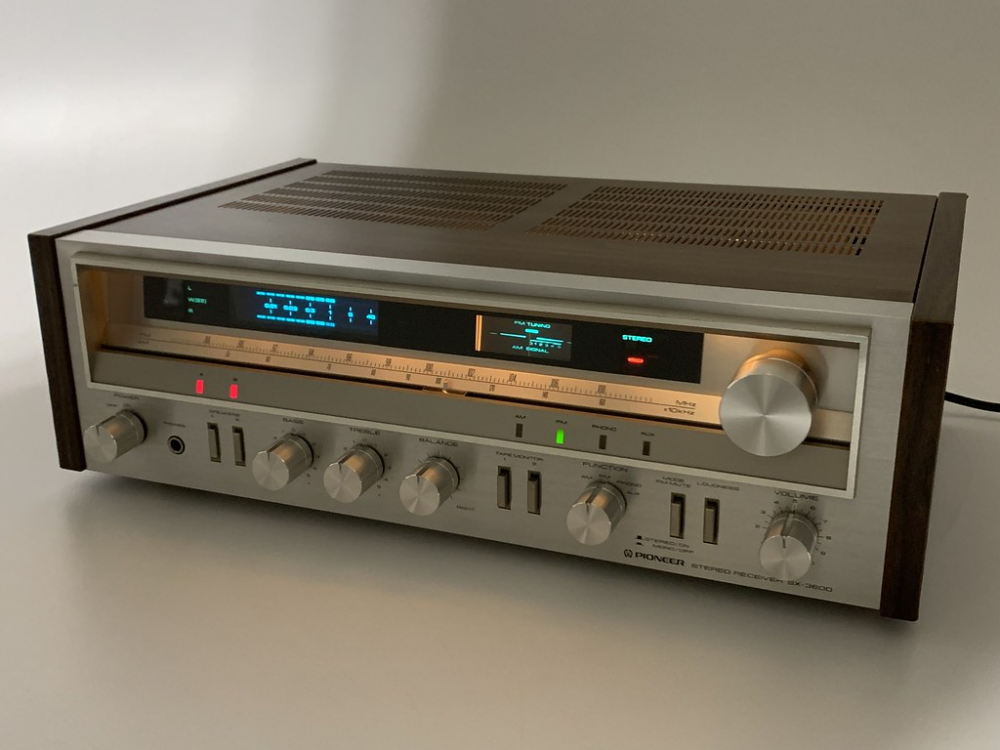
When I bought that, my teenage self was a big fan of anything with the brand name "Scott". Scott paper towels frequently found their way into Mom's shopping cart. I had a fair amount of "Scott" ski equipment. My first real stereo equipment purchase was a Scott 610D cassette deck that I acquired to hook up to an old console stereo I had found at a garage sale. I used it to make and listen to mix tapes from the radio and to make copies of LP's.
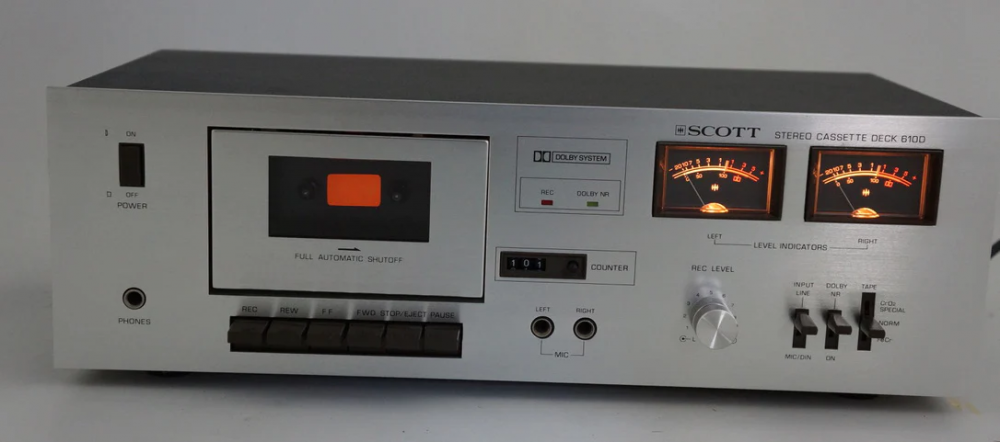
When I was receiver shopping, my first thought was to acquire a Scott receiver. By the time I had enough money saved for that, the current models were the 3x5R series. I could just about afford the 335R, which I was pretty impressed with - but I ultimately got a better deal on the aforementioned Pioneer which wound up serving me very well. More than 40 years later, I had an opportunity to acquire the Scott's big brother, the 375R, for a similar price as a nice dinner out (courtesy of an ebay seller and an in person pickup in the parking lot of a Kum and Go in Iowa City). This was too much to pass up, so here it is...
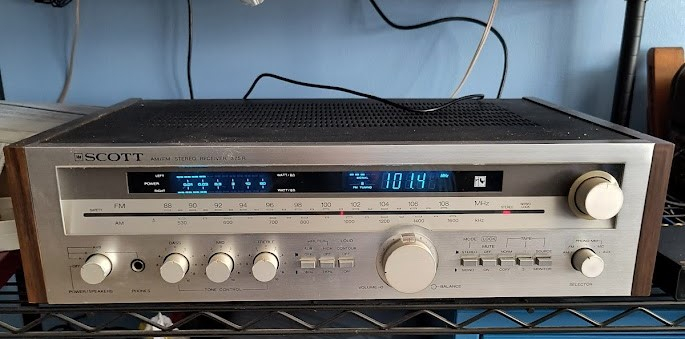
The flouroscan meters obviously came from the same source as the Pioneer's. When I hooked up and listed to the Scott 375R, it sounded powerful and neutral - quite impressive. I spent a lot of quality time with this receiver in my home office. Measurements confirm it is no slouch (or maybe a tremendous slouch to Caddyshack fans).
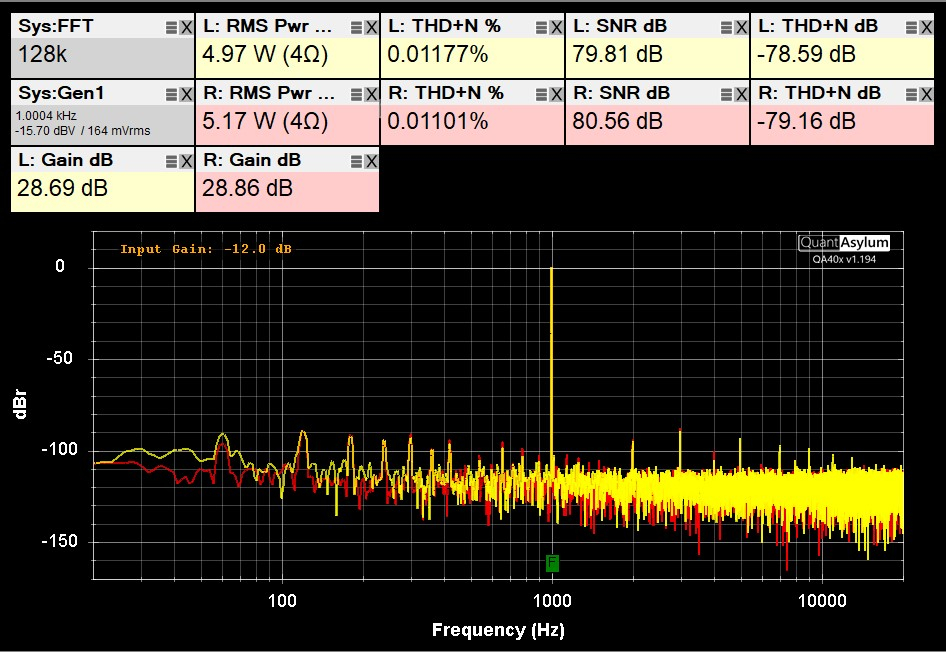
A SINAD of 79 (average of left and right channels) puts this in the lower end of Audio Science Review's good category. It might have done better if not for power supply noise, which isn't surprising for a 45 year old receiver. This receiver has triple tone controls (which along with the flouroscan power meters and Scott name would have appealed to my teenage self) which can't be defeated and has an interesting impact on frequency response.

Adjusting to get balanced (but not perfectly linear) response required the bass to be somewhere in between +1 and +2.

This is really okay as the deviations are in tenths of a dB and there is strong output at both ends of the audible spectrum. The remainder of the measurements were taken with the tone controls adjusted for the most balanced response.
The Scott 375 has legitimate power. Into 8 ohms there is 75-80 watts per channel at 1 kHz with 0.01% THD+N. At 4 ohms, we are seeing about 115 watts per channel at 0.04% THD+N
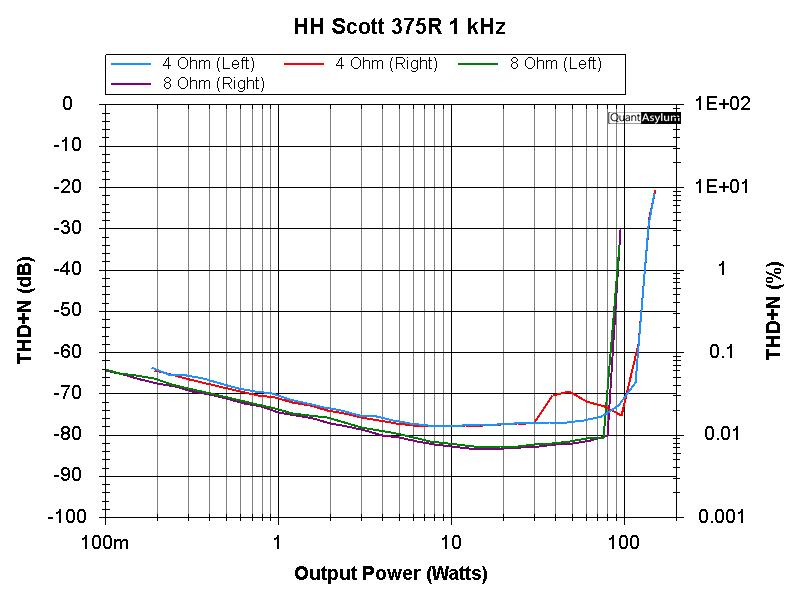
The original specs were 65 watts per channel into 8 ohms from 20 Hz to 20 kHz with less than 0.04% THD. Looking across the frequency spectrum, it appears that this receiver should have no issues. There is some increase in distortion at high frequencies, but even at 4 ohms it stays below 0.04% out to about 100 watts per channel up to 15 kHz.
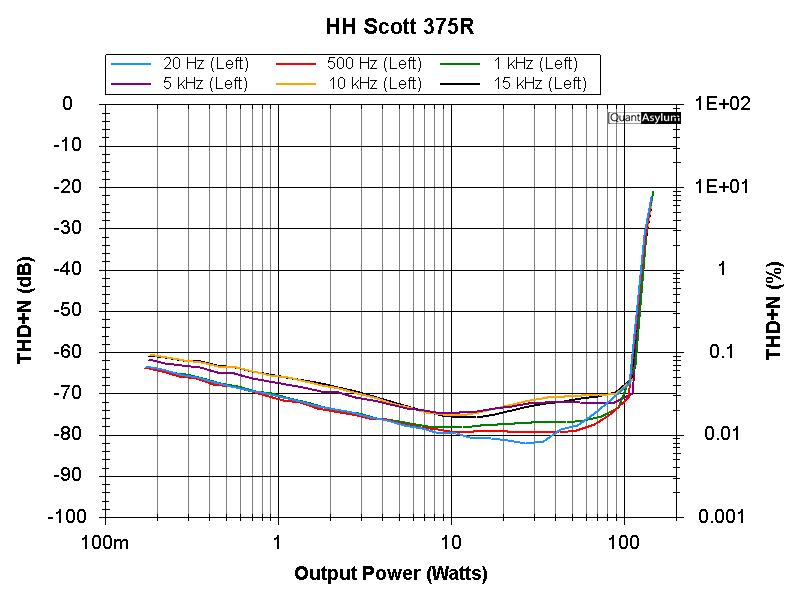
Multitone testing shows a little less resolution than the A-7, but still quite respectable. The power supply related peaks (60 Hz, and multiples) are evident, but otherwise the noise floor is at least 90 dB (15 bits) below the signal peaks at lower frequencies and 84 dB (14 bits) at high frequencies
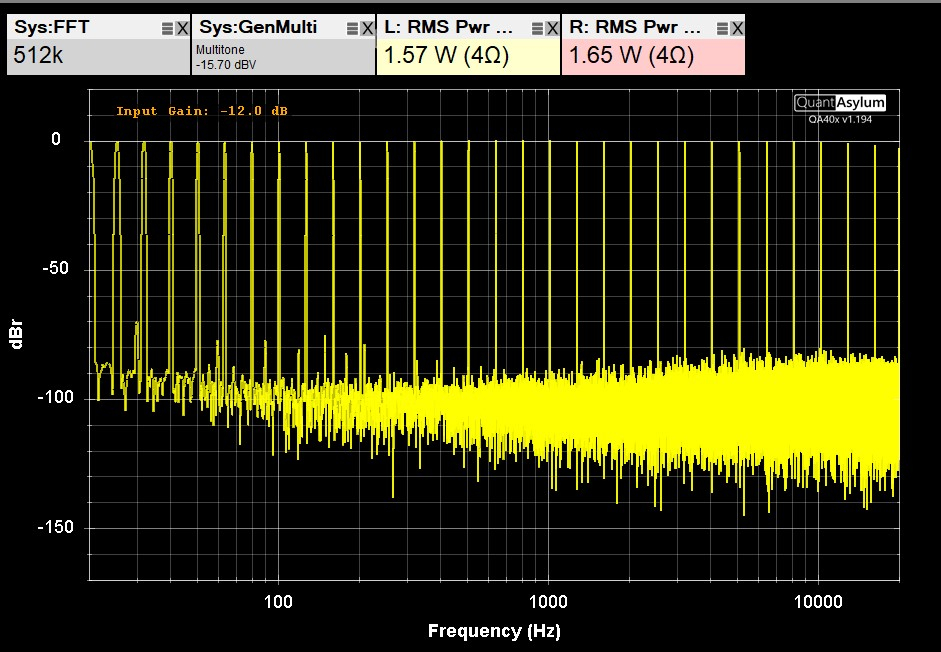
Another test I tried this time is signal to noise ratio. I used the Aux input for testing and for that input, the original spec. was 100 dB. This was measured using A-weighting, so I did that at a power level just before clipping.
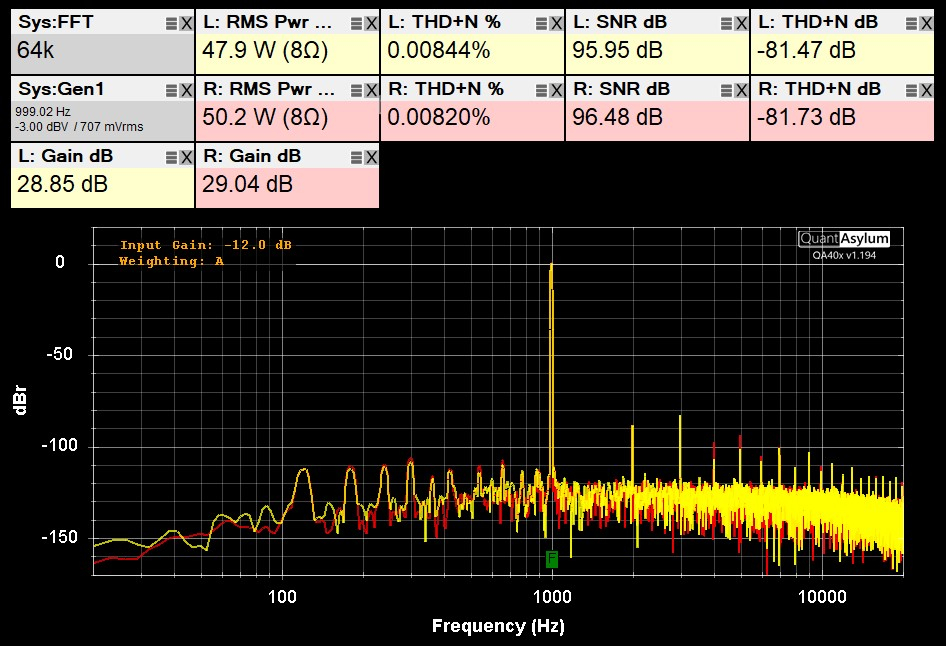
With an 8 ohm load, we have about 96 dB SNR - surprisingly close given the age of the receiver.
Along with the Pioneer A-7, this is another example of vintage audio from the 1980 time frame showing quite respectable performance even outside the realm of the thousand+ dollar highly sought after monster receivers. Yes, you can get similar performance (with the exception of linearity and distortion at high frequencies) today from TPA-3255 based amplifiers - but how many of those will run for 45 years... On top of that, this provides for me a cheap trip down memory lane. YMMV on that front.
Sehlin Sound Solutions
You just brought back some memories for me. I had a Scott 335R my freshman year at the U of I. I recall my roommate & I cooked it the following year blasting Tom Petty. It took out a woofer in my Nova 6 speakers.
Glad to hear there is a fellow Scott owner out there. Of course, the Electronics Shelter has more than two occupants. About 7 years prior to acquiring the Scott 375R, its predecessor, the 370R popped up on our local Craigslist. So, of course I ventured out to an exit off Interstate 88 in western Illinois to rescue it. This receiver has been driving the Hafnium's for years. It has a 30 Hz Low Filter that is just about perfect if one needs to crank the volume on the vented Tang Band W5-1138SMF woofer.
This is from the same model year as the 610D cassette deck pictured earlier in this thread that was my first real audio purchase, so the 370R does also take me down memory lane. It's bigger and heavier than the 375R, so it gives of a little of a monster receiver vibe, but an understated one. Original spec was 60 watts per channel into 8 ohms with less than 0.05% total harmonic distortion.
The most commonly reported issue with the 370R is the power/speaker selector switch. This one has that issue. It flickers for a few seconds before stabilizing after it is switched on. It also has a burned out bulb on the tuner signal strength meter. Besides that, it has always sounded neutral and powerful - more neutral than a number of vintage receivers and amps I have owned.
Since I also have the 375R and have tested it, I will report this as a comparative study. Starting with the 1 kHz 5W 4ohm dashboards, first the 370R followed by the 375R.
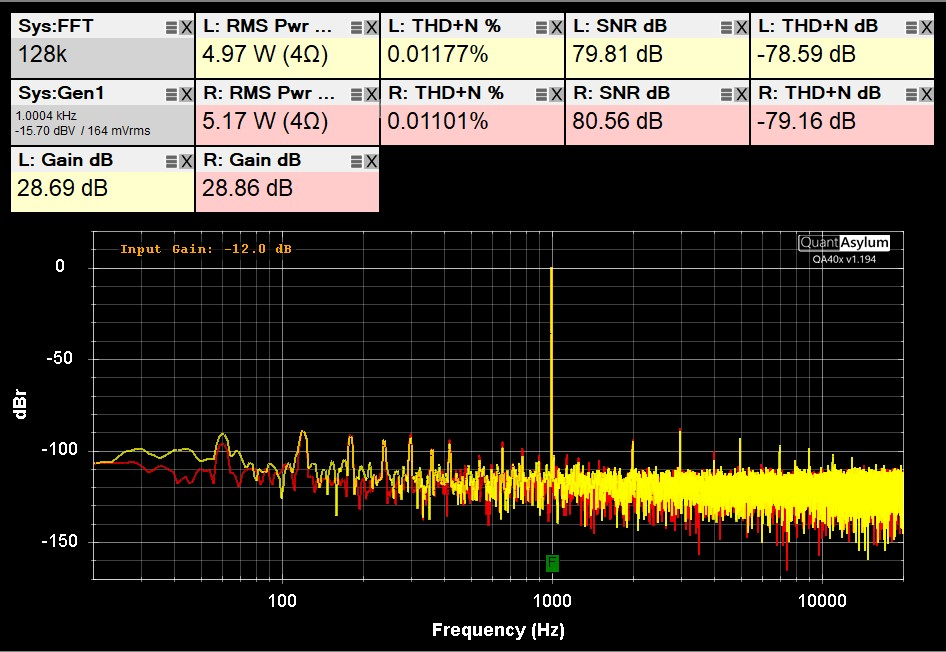
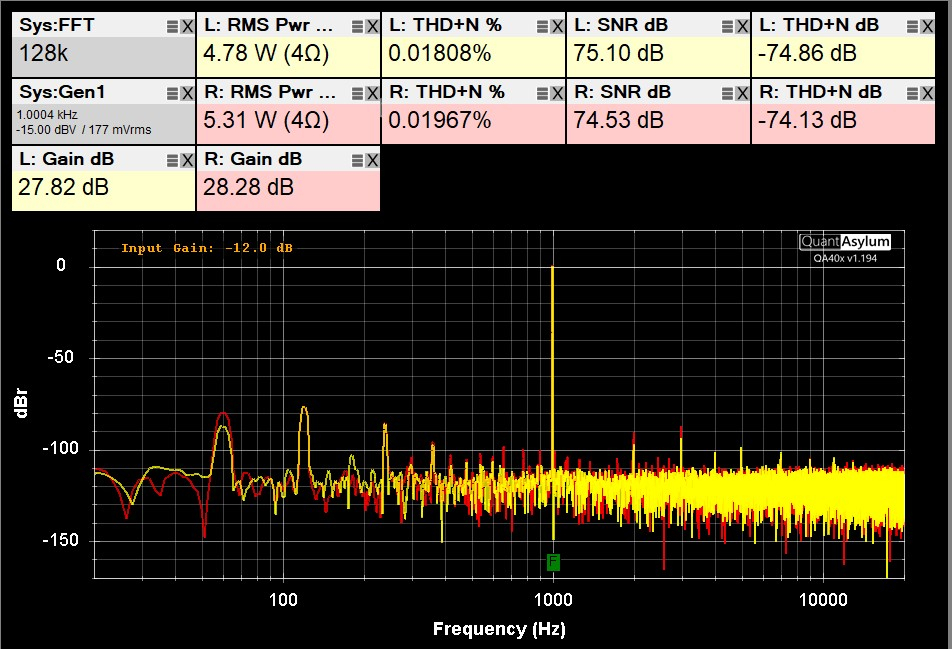
The first thing to notice is the 375R SINAD is about 5 dB lower (79 dB vs. 74 dB). Distortion (peaks to the right and multiples of 1 kHz) is almost identical between the two amps, but power supply noise 60 Hz and multiples) is higher for the 370R. Given the age, it could just be that the 370R has had a harder life.
Changing the load to 8 ohms changes the playing field a little.
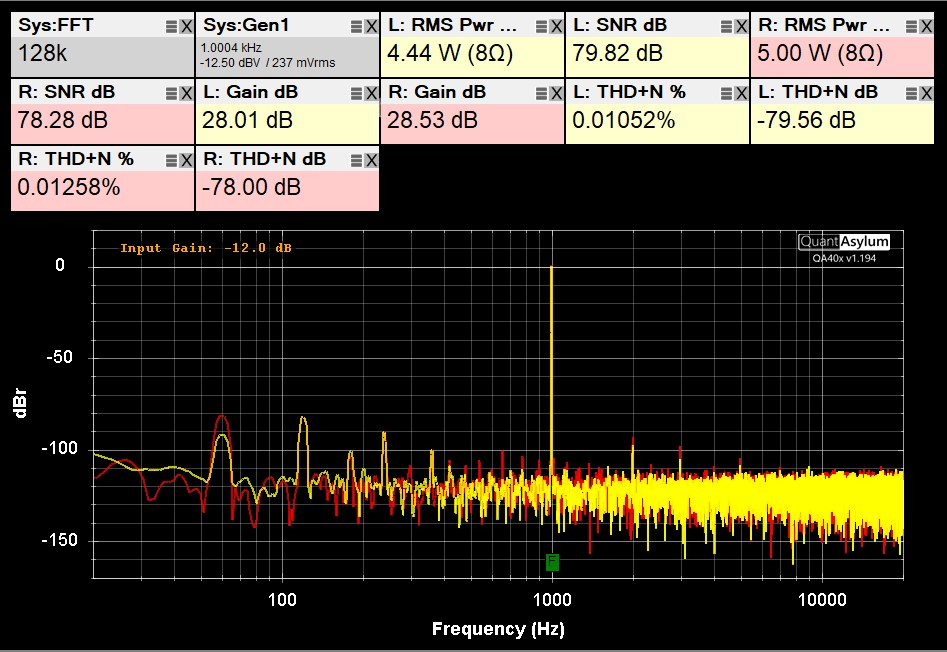

Now the SINAD is about 82 dB for the 375R and 80 dB for the 370R as its power supply is less stressed. The 370R distortion profile is now cleaner.
Frequency response with these vintage receivers frequently seems to depend heavily on the condition of the tone controls. This is definitely the case here.
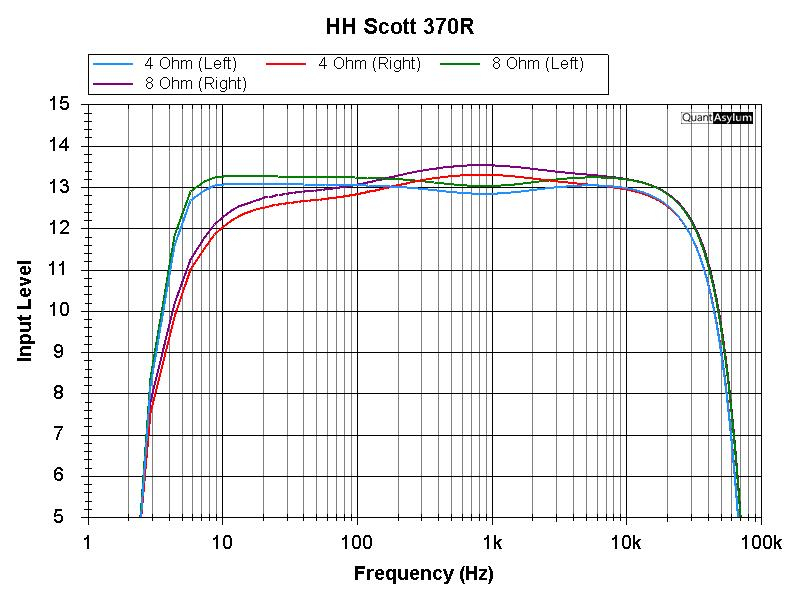

The 375R response needed about +1 on the bass knob for good balance. A similar adjustment was not possible for the 370R because the left and right channel are different. The left channel has the flattest and most extended bass response I have ever seen, but the right channel is 1 dB down at 20 Hz and has about a 1/2 dB peak centered at 1 kHz. In any event, these variances are mostly fractions of a decibel, so the 370R should still sound quite balanced, which it does.
Next, let's look at power output.
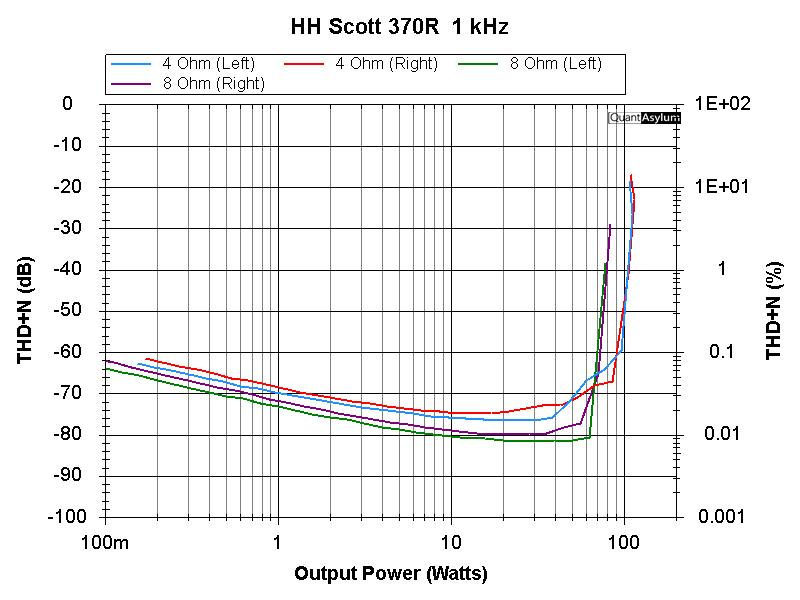
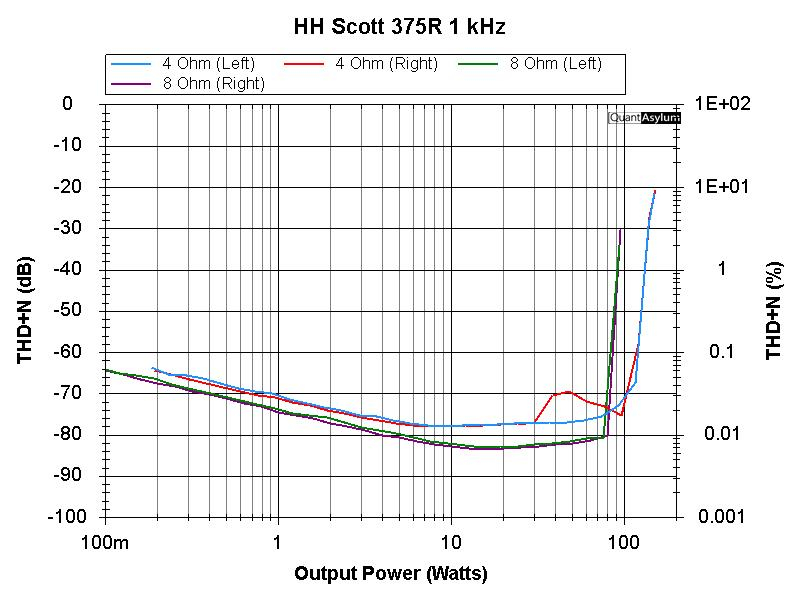
The 370R was rated at 60 watts per channel into 8 ohms at less than 0.05% THD and manages to stay below 0.01% THD+N at 60 WPC at 1 kHz. Into 4 ohms, the 370R hangs in there until about 95W. The 375R was rated at 65 WPC, but overachieves, hitting 80 WPC into 8 ohms and about 115W into 4 ohms. If anything, I would have guessed the 370R was the more underrated amp based on the size and weight.
Looking at other frequencies, the 375R looks to have the upper hand.
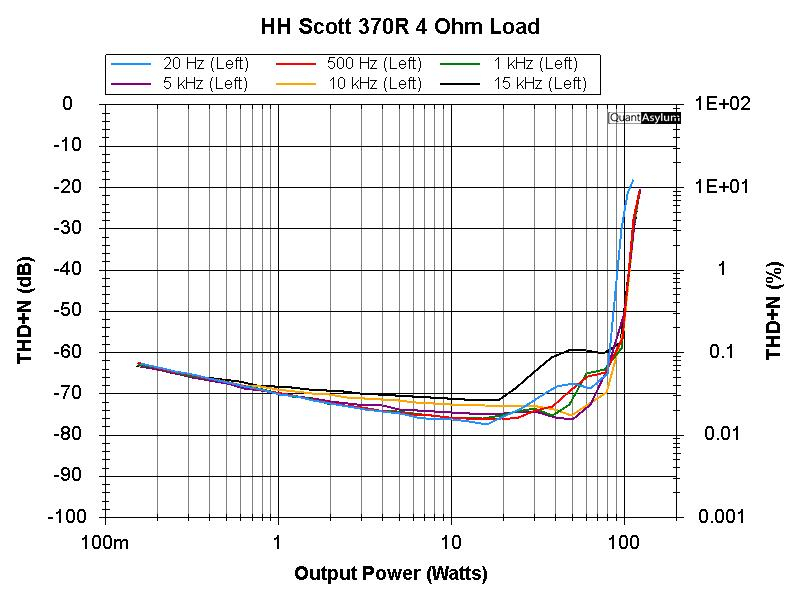
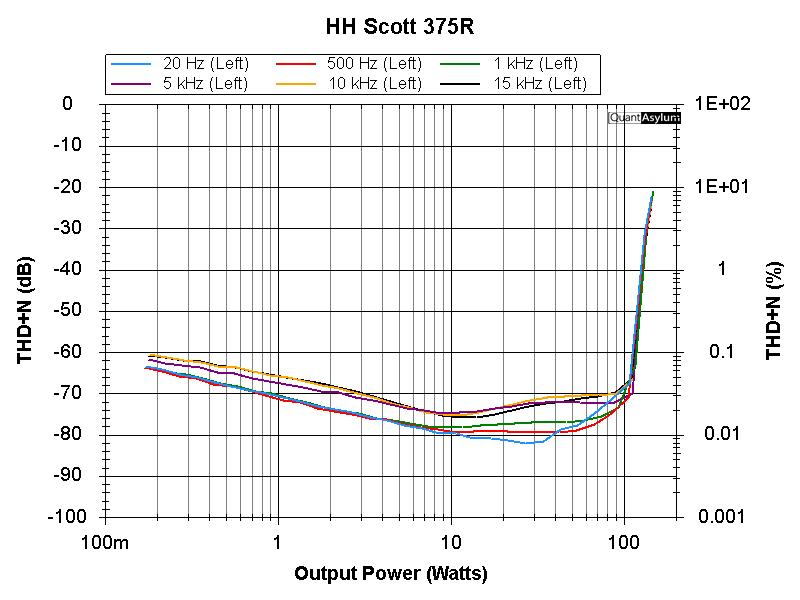
The 370R has distortion creeping up toward 0.1% at 15 kHz for higher power levels, while the 375R stays below 0.05% through that range. The other thing to note is that the 370R is running out of power a little early (running out of steam above about 80W into 4 ohms) at 20 Hz.
The 370R advertised a signal to noise ratio on the line input of 90 dB, while the 375R specified 100 dB. I got 94 dB for the 370R and 96 dB for the 375R - pretty good for receivers that are nearing 45 years old.
Sehlin Sound Solutions
I guess we still need the multitone tests. At 4 ohms (starting with the 370R, following with the 375R)

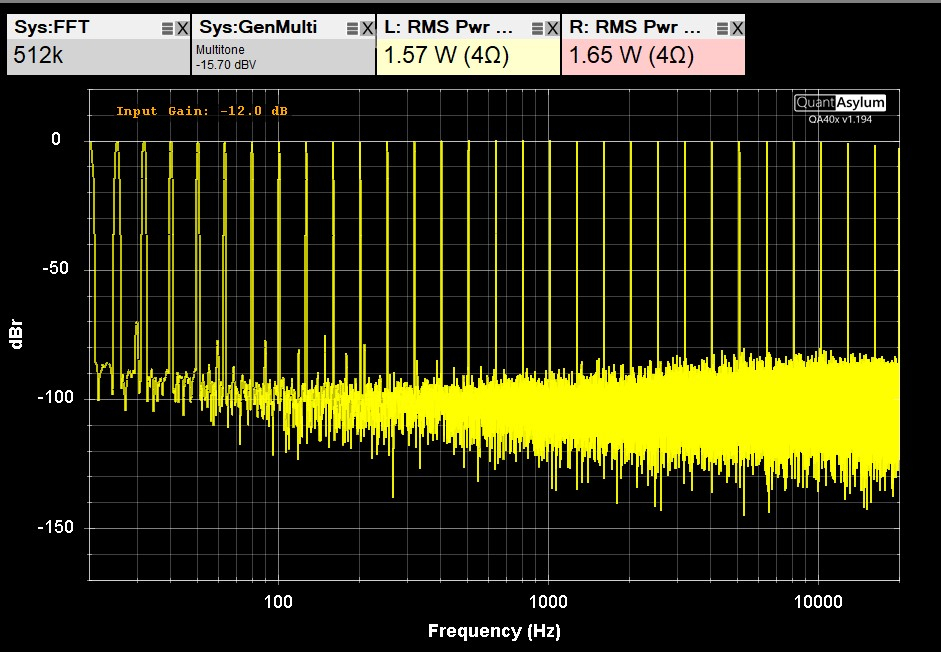
Here's a case where the 370R looks to be cleaner by a few dB (with the exception of the power supply-related peaks).
8 ohms is a similar story.
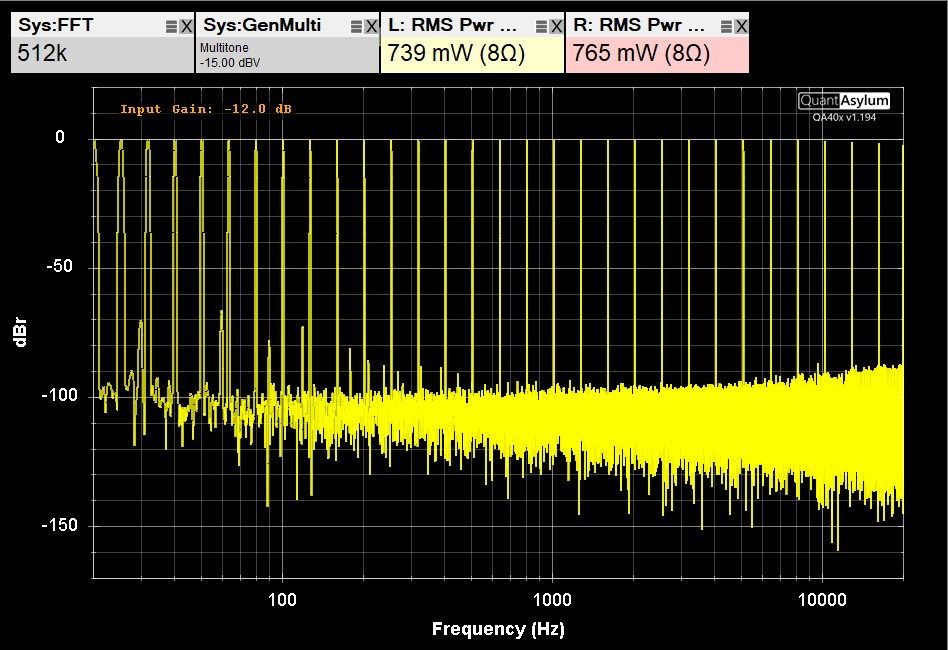
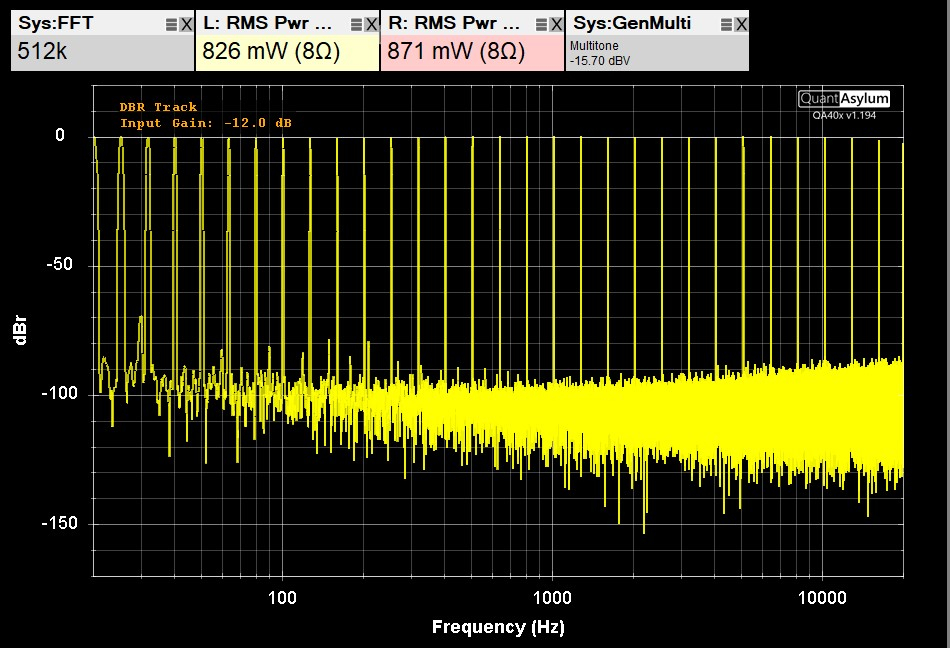
Both of these receivers are showing 16 bits of resolution through the bass and midrange - so they are no joke.
Sehlin Sound Solutions
There is a Scott 370R receiver and pair of Scott 188T speakers on my local craigslist. He's asking $300 for both.
This is on my local Craigslist, Scott 440A with matching tuner:
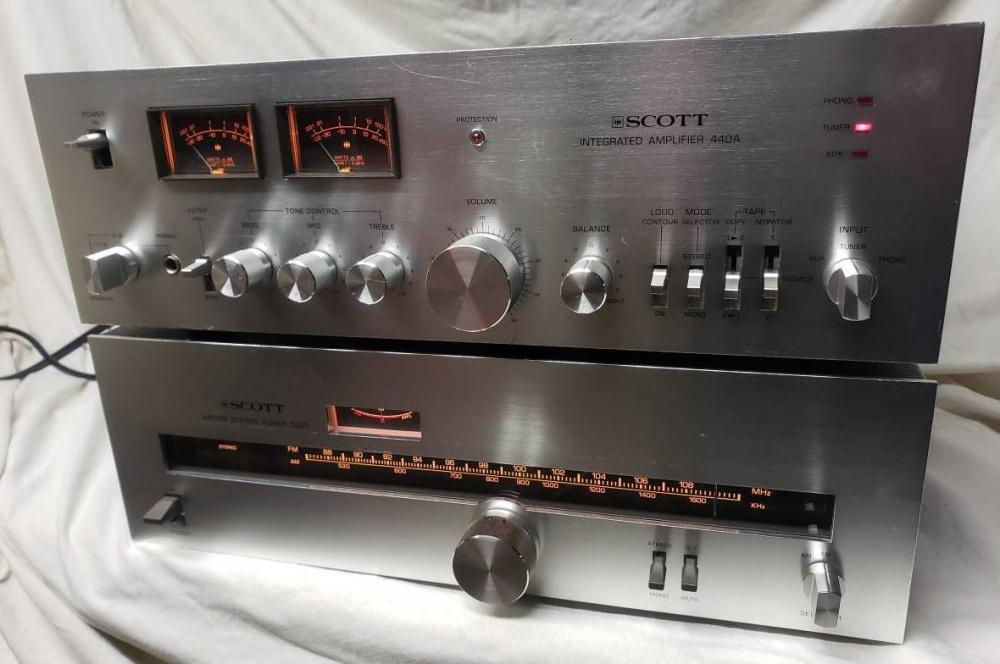
I know the guy, might be able to get it for $250, what do you think?
That's beautiful
Love the look of vintage equipment.
If everything is in working condition, I would say it's a reasonable price. The 440A has similar specs to the amp section of the 350R receiver.
Sehlin Sound Solutions
I remember the 188T's from when I was first audio shopping. They actually had a decent dome tweeter and weren't quite as Monkey coffin or bloated bookshelf- like as most of the competition. I couldn't afford them back then...
The extent to which that's a good deal depends on condition. I think I paid about $75 for my 370R, but that was about 10 years ago. I definitely think the Scott in good working condition would outperform a lot of more expensive vintage receivers from more "in demand" brand names.
Sehlin Sound Solutions
I would say jump on the 440A. It looks like it's built as well as almost anything from that era and would be very easy to work on. Plus, it's got meters!!
I kinda wish I had a use for it.